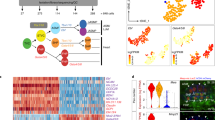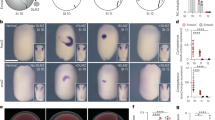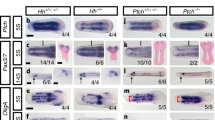Abstract
The amphibian nervous system has long been thought to arise from within a large (>103) population of dorsal ectodermal cells1, that would otherwise differentiate only as epidermis, as a result of inductive signals from underlying dorsal mesoderm at gastrulation2. It has recently been claimed, however, that small cell groups are set aside much earlier in amphibian development, as the sole founders of particular portions or ‘compartments’3 of the body plan4–6. This would imply a dramatic re-interpretation5 of classical experiments where a second dorsal blastoporal lip, grafted to the ventral side of a gastrula containing 10,000 or more cells, causes there the development of a second central nervous system (CNS) in host tissue7–9. We show that such surgically induced second nervous systems are made by host cells which have lineages separate from those that contribute to the original CNS from the 32-cell stage. Thus neural induction can occur as traditionally supposed, by assignment of ectodermal cell fate in relation to dorsal mesoderm during gastrulation. We discuss the implications of this for the recent proposals about early compartmentation in vertebrate development.
This is a preview of subscription content, access via your institution
Access options
Subscribe to this journal
Receive 51 print issues and online access
$199.00 per year
only $3.90 per issue
Buy this article
- Purchase on Springer Link
- Instant access to full article PDF
Prices may be subject to local taxes which are calculated during checkout
Similar content being viewed by others
References
Spemann, H. Embryonic Development and Induction (Haffner, New York, 1967).
Nieuwkoop, P. D. et al. J. exp. Zool. 120, 1–108 (1952).
Crick, F. H. C. & Lawrence, P. A. Science 189, 340–345 (1975).
Jacobson, M. Trends Neurosci. 1, 3–5 (1980).
Jacobson, M. in Neuronal Development (ed. Spitzer, N. C.) 45–99 (Plenum, New York, 1982).
Jacobson, M. J. Neurosci. 3, 1019–1038 (1983).
Spemann, H. & Mangold, H. Arch. microsk. Anat. EntwMech. 100, 599–638 (1924).
Cooke, J. J. Emb. exp. Morphol. 28, 27–46 (1972).
Cooke, J. Nature 242, 55–57 (1973).
Nieuwkoop, P. D. & Faber, J. Normal Table of Xenopus laevis (Daudin) (North-Holland, Amsterdam, 1956).
Nakamura, O. Annotes zool. Jap. 21, 169–236 (1942).
Smith, J. C. & Slack, J. M. W. J. Emb. exp. Morphol. (in the press).
Saxen, L. & Toivonen, S. J. Emb. exp. Morphol. 9, 514–533 (1961).
Cooke, J. J. Emb. exp. Morphol. 51, 165–182 (1979).
Keller, R. E. Devl Biol. 42, 222–241 (1975).
Keller, R. E. Devl Biol. 51, 118–137 (1976).
Author information
Authors and Affiliations
Rights and permissions
About this article
Cite this article
Gimlich, R., Cooke, J. Cell lineage and the induction of second nervous systems in amphibian development. Nature 306, 471–473 (1983). https://doi.org/10.1038/306471a0
Received:
Accepted:
Issue Date:
DOI: https://doi.org/10.1038/306471a0
This article is cited by
-
Hilde Mangold (1898?1924) and Spemann's organizer: achievement and tragedy
Roux's Archives of Developmental Biology (1996)
-
Interaction between peptide growth factors and homoeobox genes in the establishment of antero-posterior polarity in frog embryos
Nature (1989)
-
Cell lineage analysis reveals multipotency of some avian neural crest cells
Nature (1988)
Comments
By submitting a comment you agree to abide by our Terms and Community Guidelines. If you find something abusive or that does not comply with our terms or guidelines please flag it as inappropriate.



